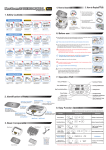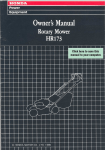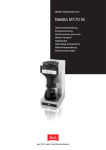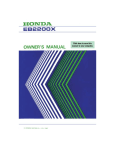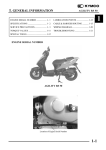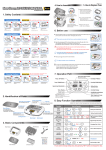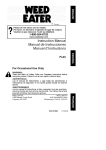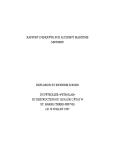Download Honda WB3OX User's Manual
Transcript
Thank you for purchasing a Honda water pump. This manual covers the operation and maintenance of WBZOX and WB3OX water pumps. All information in this publication is based on the latest product information available at the time of approval for printing. Honda Motor Co., Ltd. reserves the right to make changes at any time without notice and without incurring any obligation. The illustrations in this book are based on the WB20X unless otherwise noted. No part of this publication may be reproduced This manual should be considered a permanent remain with the pump if it is resold. Pay special attention l to statements preceded without written permission. part of the pump and should by the following words: For safety, never pump flammable or corrosive liquids such as gasoline or acid. Also, to avoid pump corrosion, never pump sea water, muddy water, chemical solutions, or caustic liquids such as used oil, wine, or milk. mzml instructions CAUTION: instructions NOTE: Indicates a strong possibility are not followed. Indicates a possibility are not followed. Gives helpful of severe personal of personal injury or death if injury or equipment damage if information. If a problem should arise, or if you have any questions sult an authorized Honda dealer. about the pump, con- Emm Honda water pumps are designed to give safe and dependable service if operated according to instructions. Read and understand the Owner’s Manual before operating the pump. Failure to do so could result in personal injury or equipment damage. It is illegal in some areas to operate an engine without a U.S.D.A. qualified spark arrester; check local laws and regulations. An optional spark arrester for this pump is available from your authorized Honda pump dealer. CONTENTS 1. 2. 3. 4. 5. 6. 7. 8. 9. 10. 1 1. SAFETY INSTRUCTIONS ........................................................... .................................................. COMPONENT IDENTIFICATION PREPARATION ......................................................................... STARTING THE ENGINE ............................................................. OPERATION ............................. . ................................................ STOPPINd THE ENGINE ............................................................. l High altitude operation ............................................................ MAINTENANCE ........................................................................ TRANSPORTING/STORAGE ....................................................... ................................................................ TROUBLESHOOTING SPECIFICATIONS ................................................................... WARRANTY SERVICE ............................................................... 1 3 5 10 12 13 14 15 20 22 .: 24 25 > 1. SAFETY INSTRUCTIONS To ensure safe operation. For safety, never pump flammable or corrosive liquids such as gasoline or acid. Also, to avoid pump corrosion, never pump sea water, muddy water, chemical solutions, or caustic liquids such as used oil, wine, or milk. l Place the pump on a firm, level surface. If the pump is tilted or overturned, fuel spillage may result. l To prevent fire hazards and to provide adequate ventilation, keep the pump at least 1 meter (3 feet) away from buildings and other equipment during operation. Do not place flammable objects close to the pump. l Children and pets must be kept away from the area of operation due to a possibility of burns from hot engine components. l Know how to stop the pump quickly, and understand the operation of all controls. Never permit anyone to operate the pump without proper instructions. l Gasoline is extremely flammable and is explosive under certain conditions. l Refuel in a well-ventilated area with the engine stopped. Do not smoke or allow flames or sparks in the refueling area or where gasoline is stored. l Do not overfill the fuel tank. After refueling, make sure the tank cap is closed properly and securely. l Be careful not to spill fuel when refueling. Spilled fuel or fuel vapor may ignite. If any fuel is spilled, make sure the area is dry before starting the engine. l Never run the engine in an enclosed or confined area. Exhaust contains poisonous carbon monoxide gas; exposure can cause loss of consciousness and may lead to death. l The muffler becomes very hot during operation and remains hot for a while after stopping the engine. Be careful not to touch the muffler while it is hot. Let the engine cool before storing the pump indoors. 1 < CAUTION LABEL GASOLINE LOCATION CAUTION > LABEL UMP FLAMMAB OR CORROSIVE MATERIALS. AN EXPLOSION OR FIRE PUMP CAUilON !~~! 2 LABEL 2. COMPONENT < WB20X> CARRYING HANDLE IDENTIFICATION FUEL CAP \ FILLER MUFFLER AIR CLEANER THROTTLE CHOKE STARTER . FUEL VALVE PRIMING FILLER WATER CAP ENGINE SWITCH PUMP DRAIN CAP LEVER LEVER GRIP < WB3OX > FUEL FILLER CAP DISCHARGE PORT CHOKE LEVER STARTER GRIP ENGINE SWITCH MUFFLER I WY PRIMING FILLER FRAME WATERCAP AIR SUCTION PUMP PORT DRAIN CLEANER - CAP/ Al-x W\ I OIL FILLER DIPSTICK CAP/ 352 ST\RAINER \ 01 L DRAIN PLUG 3. PREPARATION 1. Connect the suction hose. .Use commercially available hose, hose connector, and hose bands. The suction hose must be of reinforced, noncollapsible construction. Suction hose length should not be longer than necessary, as pump performance is best when the pump is not far above the water level. Self-priming time is also proportional to hose length. The strainer that is provided with the pump should be attached the suction hose with a band, as shown. to the end of CAUTION: Always install the strainer on the end of the suction hose before pumping. The strainer will exclude debris that can cause clogging or impeller damage. NOTE: Tighten the hose connector and bands to prevent air leakage and loss of suction. A loosely connected suction hose will reduce pump performance and self-priming ability. 2. Connect the discharge hose. Use a commercially available hose, hose connector, and hose band. A short, large-diameter hose is most efficient. Long or small-diameter hose increases fluid friction and reduces pump output. NOTE: Tighten the hose band securely ing under high pressure. to prevent the hose from disconnect- D DISCHARGE H 5 3. Check the engine oil level. CAUTION: l Engine oil is a major factor affecting engine performance and service life. Nondetergent oils and 2-stroke oils, are not recommended because they have inadequate lubricating characteristics. l Be sure to check the engine on a level surface with the engine stopped. Use Honda 4-stroke oil, or an equivalent high detergent, premium quality motor oil certified to meet or exceed U.S. automobile manufacturer’s requirements for Service Classification SE or SF, (Motor oils classified SE or SF will show this designation on the container.) SAE low-40 is recommended for general, all-temperature use. -20 , -30 4. -20 -10 Ambient , 0 60 10 80 20 30 100°F , 40°C temperature 1, Remove the oil filler cap/dipstick and wipe it clean. 2. Insert the filler cap/dipstick into the oil filler neck, but do not screw it in. 3. If the level is low, fill to the top of the oil filler neck with recommended oil. CAUTION: damage. OIL FILLER Running NECK OIL 6 the engine with FILLER CAP insufficient oil can cause serious engine 4. Check the fuel level. Your engin; ‘+” @signed to use any gasoline that has or that has ) of 86 or higher, number ( tane number if 91 or higher. Gasoline pumps at service display the pump octane number. We recommend that you use unleaded fuel because it engine and spark plug deposits and extends the life of components. a pump octane a research ocstation normally produces fewer exhaust system Never use stale or contaminated gasoline or an oil/gasoline mixture. Avoid getting dirt, dust or water in the fuel tank. Use of a lower octane gasoline can cause persistent “pinging” or heavy “spark knock” (a metallic rapping noise) which, if severe, can lead to engine damage. CAUTION: If “spark knock” or “pinging” occurs at a steady engine speed under normal load, change brands of gasoline. If spark knock or pinging persists, consult your authorized Honda dealer. Failure to do so is considered misuse, and damage caused by misuse is not covered by Honda’s Limited Warranty. Occasionally you may experience light spark knock while operating under heavy loads. This is no cause for concern, it simply means your engine is operating efficiently. After refueling, be sure to tighten Fuel tank capacity WB20X...2.5 WB30X...3.6 the fuel tank cap firmly. lit. (0.66 lit. (0.95 US gal, 0.55 US gal, 0.79 Imp gal) Imp gal) 7 Gasoline is extremely flammable and is explosive under certain conditions. Refuel in a well-ventilated area with the engine stopped. Do not smoke or allow flames or sparks in the area where the engine is refueled or where gasoline is stored. Do not overfill the fuel tank (there should be no fuel in the filler neck). After refueling, make sure the tank cap is closed properly and securely. Be careful not to spill fuel when refueling. Spilled fuel or fuel vapor may ignite. If any fuel is spilled, make sure the area is dry before starting the engine. Avoid repeated or prolonged contact with skin or breathing of vapor. KEEP OUT OF REACH OF CHILDREN. l l l l l GASOLINES CONTAINING ALCOHOL If you decide to use a gasoline containing alcohol (gasohol), be sure it’s octane rating is at least as high as that recommended by Honda. There are two types of “gasohol”: one containing ethanol, and the other containing methanol. Do not use gasohol that contains more than 10% ethanol. Do not use gasoline containing methanol (methyl or wood alcohol) that does not also contain cosolvents and corrosion inhibitors for methanol. Never use gasoline containing more than 5% methanol, even if it has cosolvents and corrosion inhibitors. NOTE: l Fuel system damage or engine performance problems resulting from the use of fuels that contain alcohol is not covered under the warranty. Honda cannot endorse the use of fuels containing methanol since evidence of their suitability is as yet incomplete. l Before buying fuel from an unfamiliar station, try to find out if the fuel contains alcohol, if it does, confirm the type and percentage of alcohol used. If you notice any undesirable operating symptoms while using a gasoline that contains alcohol, or one that you think contains alcohol, switch to a gasoline that you know does not contain alcohol. 8 5. Check the air cleaner element. Remove the wing nut, washer and air cleaner cover. Check the element for dirt or obstruchtion. Clean the element if necessary (see page 17). CAUTION: Never run the engine without the air cleaner. Rapid engine wear will result from contaminants, such as dust and dirt, being drawn through the carburetor, into the engine. AIR CLEANER COVER AIR CLEANER ELEMENT 6. Check the priming water. The pump chamber should be completely filled before operating. CAUTION: Never attempt to operate the pump without priming water or the pump will overheat. Extended dry operation will destroy the pump seal. If the unit has been operated dry, stop the engine immediately and allow the pump to cool before adding priming water. PRIMING WATER 4. STARTING THE ENGINE 1. Turn the fuel valve ON. 2. Close the choke lever. NOTE: Do not use the temperature is high. choke ; FUEL 3. Turn the engine switch to‘the 10 VALVE if the engine CHQKE ON position. LEVER is warm or the ambient 4. Move the throttle lever slightly to the left. THROTTLE 5. Pull the starter grip lightly until LEVER resistance is felt, then pull it briskly. CAUTION: Do not allow the starter grip to snap back against the engine. Return it gently to prevent damage to the starter. STAliTER GRIP 11 5. OPERATION 1. As the engine warms up, gradually 2. Set the throttle open the choke. at the desired speed. THROTTLE 12. LEVER 6. STOPPING THE ENGINE 1. Move the throttle lever fully to the right. 2. Turn the engine switch to the OFF position. THROTTLE LEVER 3. Turn the fuel valve OFF. FUEL VALVE NOTE: To stop the engine in an emergency, OFF position. turn the engine switch to the 13 High altitude operation At high altitude, the standard carburetor air-fuel mixture will be excessively rich. Performance will decrease, and fuel consumption will increase. High altitude performance can be improved by installing a smaller diameter main fuel jet in the carburetor and readjusting the pilot screw. If you always operate the water pump at altitudes higher than 6,000 feet above sea level, have your authorized Honda Water Pump dealer perform these carburetor modifications. Even with suitable carburetor jetting, engine horsepower will decrease approximately 3.5% for each 1,000 foot increase in altitude. The affect of altitude on horsepower will be greater than this if no carburetor modification is made. CAUTION: Operation of the Water Pump at an altitude lower than the carburetor is jetted for may result in reduced performance, overheating, and serious engine damage caused by an excessively lean air/fuel mixture. 14 7. MAINTENANCE The purpose of the maintenance and adjustment schedule is to keep the engine in the best operating condition. Inspect or service is scheduled in the table below. m Shut off the engine before performing any maintenance. If the engine must be run, make sure the area is well ventilated. The exhaust contains poisonous carbon monoxide gas; exposure can cause loss of consciousness and may lead to death. CAUTION: If the pump has been used with sea water, muddy water, etc., pump clean, fresh water through the pump immediately afterward to reduce corrosion and remove sediment. l Use only genuine HONDA parts or their equivalent. The use of replacement parts which are not of equivalent quality may damage the engine. l Maintenance NOTE (1): (2): Schedule Service more frequently when used in dusty areas. These items should be serviced by an authorized Honda dealer, unless the owner proper tools and is mechanically proficient. See the Honda Shop Manual. has the 15 1. Changing oil Drain the oil while draining. the engine is still warm to assure rapid and complete 1. Remove the oil filler cap and the drain plug, then drain the oil. 2. Reinstall the drain plug and tighten securely.. 3. Refill with the recommended oil (see page 6) to the specified level. 01 L CAPACITY: a!( DRAIN 0.6P (0.63 US qt) yy PLUG OIL LEVEL CAUTION: Used motor oil may cause skin cancer if repeatedly left in contact with the skin for prolonged periods. Although this is unlikely unless you handle used oil on a daily basis, it is still advisable to thoroughly wash your hands with soap and water as soon as possible after handling used. oil. NOTE: Please dispose of used motor oil in a manner that is compatible with the environment. We suggest you take it in a sealed container to your local service station for reclamantion; Do not throw it in the trash or pour it on the ground. 16 2. Air cleaner service A dirty air cleaner will carburetor malfunction, frequently when operating restrict air flow to the carburetor. To prevent service the air cleaner regularly. Service more the pump in extremely dusty areas. B Never use gasoline or low flash point cleaner element. A fire or explosion could result. solvents for cleaning the air CAUTION: Never run the pump without the air cleaner. Rapid engine wear will result from contaminants, such as dust and dirt being drawn through the carburetor, into the engine. 1. Unscrew the wing nut, remove the air cleaner cover and remove the foam element. 2. Wash the element in a non-flammable or high flash point solvent and dry it thoroughly. 3. Soak the element in clean engine oil and squeeze out the excess oil. 4. Reinstall the air cleaner element and the cover. AIR CLEA AIR CLEANER ELEMENT 17 3. Spark plug service Recommended spark plug: BPRGES (NGK) W20EPR-U (ND) To ensure proper engine operation, and free of deposits. the spark plug must be properly gapped 1. Remove the spark plug. M If the engine has been running, careful not to touch the muffler, the muffler will be very hot. Be MUFFLE 2. Visually inspect the spark plug. Discard it if the insulator is cracked or chipped. Clean the spark plug with a wire brush if it is to be reused. 3. Measure the plug gap with a feeler gauge. The gap should be 0.7-0.8 mm (0.028-0.031 in). Correct as necessary by bending the side electrode. 0.7-0.8 mm (0.028-0.031 18 in) 4. Thread the plug in by hand to prevent cross-threading. 5. Tighten a new spark plug l/2 turn with the wrench to compress the washer. turn after the plug If you are reusing a plug, it should only take l/8-1/4 seats. CAUTION: The spark plug must be securely tightened. An improperly tightened plug can become very hot and damage the engine. Spark plugs which have an improper heat range may cause engine damage. 19 8. TRANSPORTING/STORAGE m When transporting the pump, turn the fuel valve OFF and keep the pump level to prevent fuel spillage. Spilled fuel or fuel vapor may ignite. To avoid severe burns or fire hazards, let the engine cool before transporting the pump or storing it indoors. Before storing the pump for an extended period; 1. Be sure the storage area is free of excessive humidity and dust. 2. Clean the pump interior. . . . . Sediment will settle in the pump if it has been used in muddy or sandy water, or water containing heavy debris. Pump clean water through the pump before shutting down or impeller may be damaged when restarting. After flushing, remove the pump drain plug, drain as much water as possible from the pump housing and replace the plug. 3. Drain the fuel. . . . . a. With the fule valve OFF, remove the carburetor float bowl and drain the carburetor. Drain the gasoline into a suitable container. b. Turn the fuel valve ON and drain the gasoline in the fuel tank into a suitable container. c. Reinstall the carburetor float bowl. FLOAi 20 BOWL 4. Pull the starter cord until resistance is felt. Continue pulling until the notch on the starter pulley aligns with the hole on the recoil starter (see illustration below). At this point, the intake and exhaust valves are closed, and this will help to protect the engine from internal corrosion. Align the mark-on the starter pulley with. the hole at the top of recoil starter. 5. Change engine oil. 21 9. TROUBLESHOOTUNG When the engine will not start: 1. Is the engine switch ON? 2. Is there enough fuel? 3. Is the fuel valve on? 4. Is gasoline reaching the carburetor? To check, remove the float bowl and turn the fuel valve on. Fuel should flow out free. If any fuel is spilled, make sure the area is dry before testing ra!m spark plug or starting the engine. Spilled fuel or fuel vapor may ignite. the FLOAYBOWL 5. Is there a spark at the spark plug? a. Remove the spark plug cap. Clean any dirt from around the spark.plug base, then remove the spark plug. b. Install the spark plug in the plug cap. c. Turn the engine switch on. d. Ground the side electrode to any engine ground, pull the recoil starter to see if sparks jump across the gap. e. If there are no sparks, replace the plug. If OK, install the new plug and try to start the engine according to the 9 instructions. 6. If the engine still does not start, take the pump to an authorized water pump dealer. 22 Honda When the pump does not pump water; 1. Is the pump fully primed? 2. 3. 4. 5. 6. Is the strainer clogged? Are the hose bands installed securely? Are the hoses damaged? Is the suction head too high? If the pump still does not pump the water, take the pump to an authorized Honda water pump dealer. 23 10. SPECIFICATI(SNS Model Dimensions WB20X WB3OX 1 and Weight Length x Width Dry weight x Height (mass) 445 x 345 x 395 mm (17.5 x 13.6 x 15.6 in) 515x400x450mm (20.3 x 15.7 x 17.7 in) 19.5 kg (43.0 27.0 kg (59.5 lb) lb) Engine Model Engine GXllO GX140 4-stroke, type over head valve, 1 cylinder Displacement [Bore x Stroke] 107 cc (6.6 cu in) [57 x 42 mm (2.2 x 1.7 in)] 144 cc (8.8 cu in) [64 x 45 cm (2.5 x 1.8 in)1 Max. 3.5 5.0 output Max. torque rpm 0.7 kg-m (5.2 ft-lb)/ 2,500 rpm 1 Cooling system Ignition system PTO shaft PSl3.600 PS/3,600 rpm 1 .O kg-m (7.7 ft-lb)/ 2,500 rpm Forced Transistor air magneto Counterclockwise rotation Pump Suction port diameter Discharge Rated Total I 50 mm port diameter revolutions head Suction head Capacity. Self-priming Continuous 24 time running time 1 80 mm (2 in) (3 in) 50 mm (2 in) 80 mm (3 in) 3,550 3,550 rpm rpm 32 m (105ft) 28 m (92 ft) 8 m (27.9 ft) 8 m (27.9 ft) 500 Q (132 US gal)/min 1,000 II (264 US gal)/min llOsecat5m 150 set at 5 m (16.5 ft) 2h 30 min (16.5ft) 2h 30 min 1 ‘PI. WARRANTY Owner SERVICE Satisfaction Your satisfaction and goodwill are important to your dealer and to us. All Honda warranty details are explained in the Distributor’s Limited Warranty. Normally, any problems concerning the product will be handled by your dealer’s service department. If you have a warranty problem that has not been handled to your satisfaction, we suggest you take the following action: l l Discuss your problem with a member of dealership management. Often complaints can be quickly resolved at that level. If the problem has already been reviewed with the Service Manager, contact the owner of the dealership or the General Manager. If your problem still has not been resolved to your satisfaction, contact the Power Equipment Customer Relations Department of American Honda Motor Co., Inc. American Honda Motor Co., Inc. Power Equipment Customer Relations P.O. Box 50 Gardena, California 90247-0805 Telephone: (213) 604-2400 We will need the following - information Your name, address, and telephone Product model and serial number Date of purchase Dealer name and address Nature of the problem Department in order to assist you: number After reviewing all the facts involved, you will be advised of what action can be taken. Please bear in mind that your problem will likely be resolved at the dealership, using the dealer’s facilities, equipment, and personnel, so it is very important that your initial contact be with the dealer. Your purchase of a Honda product is greatly appreciated by both your dealer and American Honda Motor Co., Inc. We want to assist you in every way possible to assure your complete satisfaction with your purchase. 25 MEMO 26.

































